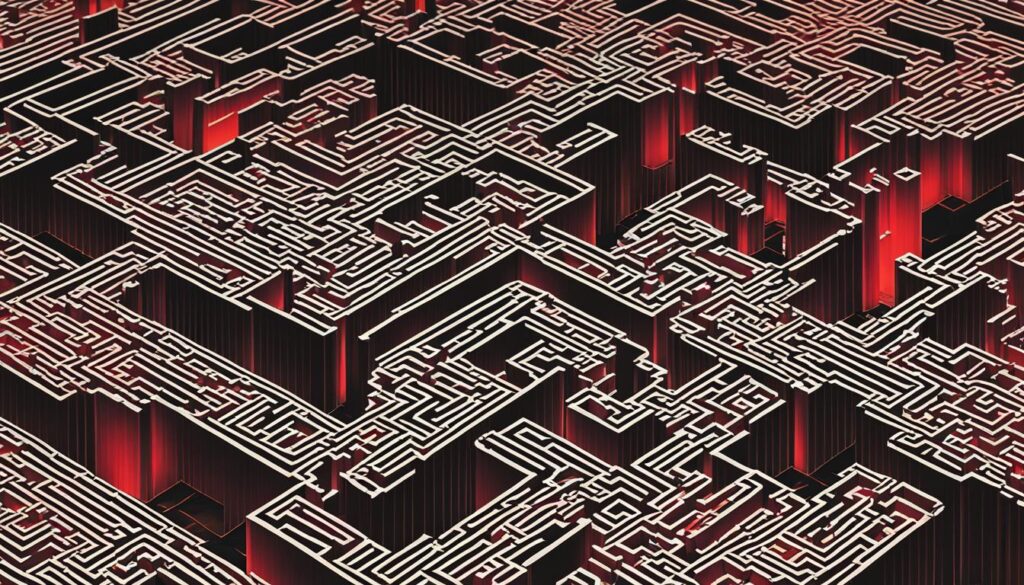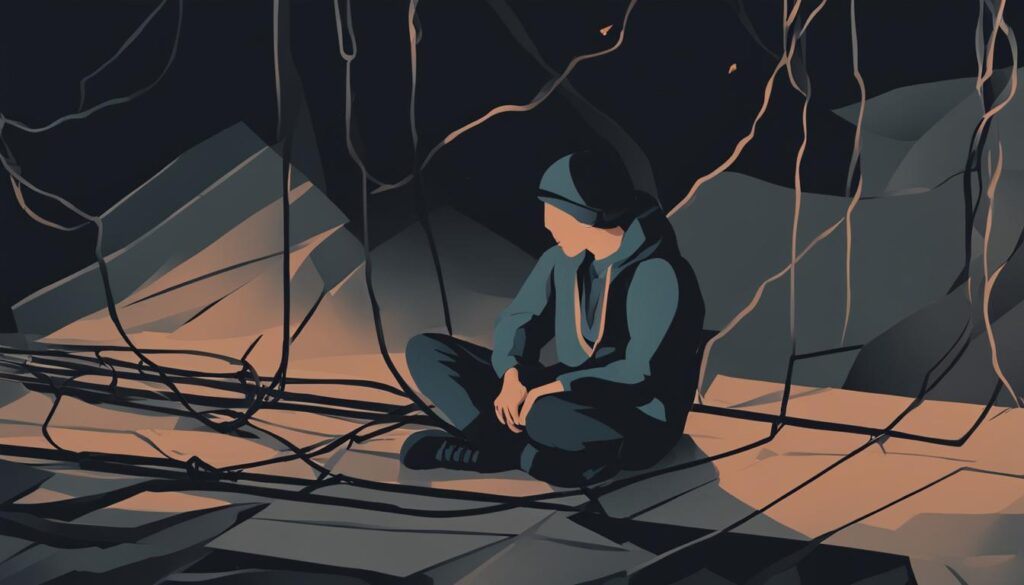When whispers of melancholy grow into a thunderous calamity within, you know you’re faced with a beast unlike any ordinary downswing. You’re not alone in this—crippling depression grips the minds of many, yet understanding it is the first step towards overcoming this formidable foe. Embarking on this comprehensive guide to depression will offer you the insights and knowledge to confront the shadow and seek the light of recovery. This resource is designed with empathy and expertise, as we navigate the trenches of this condition together.
In this guide, we’re not just skimming the surface. We’re delving deep into the heart-wrenching realities of severe depression and exploring every facet of how it transcends beyond mere sadness. Your journey through these pages will illuminate the path to empowerment and overcoming depression, bringing clarity to the murky waters that may have clouded your perspective.
The significance of this guide can’t be overstated, with its compassionate insights and strategic tools tailored for you. Hold tight—this is where your understanding of crippling depression begins to morph from confusion to clarity.
What is Crippling Depression?

When the weight of despair becomes so heavy that it infiltrates every aspect of your life, you may be facing the stark reality of crippling depression. Unlike the ebb and flow of general sadness, this level of depression can significantly disrupt your ability to function daily.
Defining Severe Depression and Its Impact
The definition of crippling depression often aligns with the characteristics of Major Depressive Disorder (MDD) and Clinical Depression. These conditions encompass a severe impact on an individual’s mood, thoughts, and physical health. We’re talking about more than just feeling down; this is an all-encompassing darkness that impairs your work performance, relationships, and leaves a profound effect on your overall well-being.
The effects of crippling depression can be debilitating, making it challenging to manage even the simplest tasks. The profound exhaustion, hopelessness, and pervasive sadness signify its severity beyond what words can typically convey.
The severe depression impact is not to be underestimated; it’s like carrying a shadow that dampens enthusiasm for life—with profound repercussions on one’s physical health too, from disrupted sleep patterns to a weakened immune system.
Major Depressive Disorder vs. Clinical Depression
While Major Depressive Disorder and Clinical Depression are often used interchangeably, it’s crucial to understand their similarities and differences. Both terms describe a debilitating form of depression, yet Clinical Depression is more a colloquial term that encompasses various types of depressive conditions, including MDD.
| Criteria | Major Depressive Disorder (MDD) | Clinical Depression |
|---|---|---|
| Definition | A medical condition diagnosed by precise criteria in the DSM-5 | A general term often used to describe a severe state of depression |
| Duration | At least two weeks of consistent symptoms | May refer to depression lasting for varying lengths of time |
| Symptoms | Persistent sadness, loss of interest, and other symptoms that impair daily life | Can encompass symptoms of MDD or other forms of depression |
Insights into Chronic and Persistent Depressive Disorders
Delving into the realm of long-term depression insights, it becomes clear that Chronic Depression and Persistent Depressive Disorder (PDD) carry the burdensome hallmark of a relentless, unforgiving course. These subtypes of depressive disorders last for at least two years, often longer, making coping with day-to-day life a herculean task. The terms are fairly synonymous, with Persistent Depressive Disorder being the current terminology used to describe a chronic form of depression.
- Chronic Depression typically refers to a persistent, long-term form of depression.
- Persistent Depressive Disorder (PDD), formerly known as dysthymia, symbolizes an extended period where an individual grapples with depressive symptoms that might be less intense but are more enduring.
The debate over the differences between depressive disorders is ongoing, but the shared experience is the relentless struggle that accompanies each day. Regardless of label, the need for understanding and effective treatment is paramount for those ensnared within depression’s grasp.
As you further unravel the intricate tapestry of depressive disorders, remember that each thread represents a life touched by this condition—their stories and struggles underscoring the critical need for awareness and support.
Identifying the Symptoms of Crippling Depression
Recognizing the Symptoms of Crippling Depression is fundamental to addressing the condition head-on. Knowing what signs to watch for can be life-changing, whether for yourself or someone close to you who might be silently grappling with severe depression. Let us unravel the telltale indicators that may signal the presence of such an intense mental health struggle.
Emotional symptoms are often the most recognizable depression signs. These may range from pervasive sadness and crying spells to feelings of hopelessness or worthlessness. Sufferers may withdraw from hobbies or activities once enjoyed and showcase a marked decrease in energy and motivation. Heightened irritability, agitation or frustration, even over trivial matters, is also common.
Equally crucial to acknowledge are the physical symptoms of crippling depression. Chronic fatigue, despite adequate sleep, and significant changes in appetite or weight are red flags. Physical ailments like headaches, pain that doesn’t respond to treatment, or digestive issues without a clear cause might also be associated with depression.

The psychological weight of depression is also manifest in cognitive and behavioral changes. These might include having trouble concentrating, remembering, or making decisions – everyday tasks become formidable opponents. Insomnia or oversleeping are widespread sleep disturbances associated with severe depression.
It’s like being shackled in a room with dimming lights, and every attempt to break free sinks you deeper into the dark abyss of despair.
Behaviors often shift, such as neglecting responsibilities or personal hygiene, which may indicate a struggle with depression. A growing disinterest in social interactions or persistent avoidance of friends and family is another concerning sign.
Checklist of Depression Signs
- Persistent sad, anxious, or “empty” mood
- Loss of pleasure in hobbies and activities
- Feelings of hopelessness, or pessimism
- Irritability
- Decreased energy or fatigue
- Moving or talking more slowly
- Feeling restless or having trouble sitting still
- Difficulty concentrating, remembering, or making decisions
- Insomnia, early-morning awakening, or oversleeping
- Appetite and/or weight changes
- Thoughts of death or suicide, or suicide attempts
- Aches or pains, headaches, cramps, or digestive problems without a clear physical cause that do not ease even with treatment
For those recognizing severe depression symptoms in themselves or others, it’s imperative to view these indicators as a critical call to action. By understanding and identifying these signs, the journey towards seeking help and healing can begin.
As we can see, the fabric of depression is woven with both mental and physical threads, crafting a garment that can suffocate one’s vibrancy and zest for life. Below is a table providing a clear delineation of the various depression signs to be mindful of:
| Aspect | Emotional Symptoms | Physical Symptoms | Behavioral/Cognitive Symptoms |
|---|---|---|---|
| Primary Signals | Sadness, hopelessness, agitation | Chronic fatigue, sleep disturbances | Lack of concentration, withdrawal |
| Common Patterns | Loss of interest, unexplained crying | Appetite changes, unexplained aches | Neglecting responsibilities, isolation |
| Severe Indicators | Thoughts of suicide or death | Persistent pain without clear cause | Extreme difficulty in decision-making |
The importance of identifying and understanding these symptoms cannot be understated. If you or a loved one are experiencing any combination of these depression signs, reaching out for professional help is a crucial next step. You’re not alone, and with support, the journey to recovery is within reach.
Exploring the Causes and Risk Factors
Every journey has its origins, and understanding the roots of crippling depression is no different. It’s a complex interplay of various elements, a culmination of both invisible threads and perceptible factors that can weave through your life and affect your mental well-being. As we unpack these influences, keep in mind that depression is a multifaceted beast—its onset brought forth by a unique blend of personal circumstances and inherent predispositions.
Genetic Influences and Family History
Have you ever wondered if depression runs in the family? With current research diving into depression genetic influences, the evidence suggests that your genetic makeup can indeed predispose you to this condition. Family history of depression serves as a crystal ball, offering a glimpse into potential hereditary depression risk factors. So, when your family tree has more than its fair share of individuals plagued by depression, it may indicate a genetic vulnerability to developing the condition yourself.
While you don’t inherit depression as you do eye color, the complex constellation of genes increases the likelihood of its occurrence. Picture it as a hidden inheritance that may or may not become your reality.
- Hereditary Patterns: Medical studies often point to certain genetic patterns that recur in families afflicted by depression.
- Vulnerability: These patterns may not be direct causes but create a susceptibility that, when combined with life events, can trigger depression’s onset.
Environmental Triggers and Life Events
The causes of depression aren’t solely etched in DNA; they also bloom from the soil of our environment. Sometimes, it’s the profound life events causing depression—the loss of a loved one, the end of a significant relationship, or even sudden unwanted changes in life circumstances. Exposure to chronic stress, another form of Depression Environmental Triggers, is akin to the slow drip of poison, leading to stress-induced depression, which ravages the psyche over time.
The brush with such environmental factors doesn’t always lead to depression but can ignite it in those already primed by their genetic predisposition. Thus, understanding the nuances becomes key to unraveling this intricate puzzle.
The Role of Neurochemistry and Physical Health
When discussing the unseen forces of crippling depression, one must consider the Neurochemistry of Depression. This neurochemical narrative features neurotransmitters as the protagonists, where an imbalance may lead to a cascade of mood and emotional disturbances, setting the stage for depression.
Concurrently, physical health depression links are becoming increasingly apparent through research. Chronic pain, prolonged illness, or other physical health challenges can exacerbate or even initiate depressive episodes. Wellness is holistic—your mental health is entwined with the physical, making the overall state of your body an influential player in the realm of depression.
Let’s map out these factors with a closer look to see how they are interconnected:
| Depression Factor | Role in Development | Potential Impact |
|---|---|---|
| Genetics and Family History | Indicator of predisposition | May increase susceptibility to depression due to inherited genetic vulnerabilities |
| Environmental Triggers and Life Events | Act as immediate catalysts | Can initiate or exacerbate depression, especially when combined with genetic predispositions |
| Neurochemistry | Influence mood and emotions | Imbalances may contribute to the onset of depressive symptoms |
| Physical Health | Overall well-being influence | Chronic illness or pain can trigger or worsen depression |
Recognizing the interplay between biological factors in depression enables you to appreciate the complexity of its roots deeply. Yet, understanding is empowerment, bringing forth not just insight but potential avenues for interception and aid. Though the causes are intricate and layered, your story doesn’t end with predispositions or experiences—you have the agency to navigate this.

Comprehensive Treatment Options for Severe Depression
Confronting severe depression requires a multifaceted treatment plan personalized to meet your unique needs. Understanding the comprehensive range of treatment options is paramount in devising an effective strategy to combat this formidable condition.
Medications and Pharmacotherapy
Depression Medications play an integral role in managing the biochemical imbalances associated with severe depression. Pharmacotherapy for Depression commonly involves using antidepressants that are designed to correct neurotransmitter imbalances, potentially improving mood and alleviating symptoms.
There are several types of antidepressants available:
- Selective Serotonin Reuptake Inhibitors (SSRIs)
- Serotonin and Norepinephrine Reuptake Inhibitors (SNRIs)
- Tricyclic Antidepressants (TCAs)
- Monoamine Oxidase Inhibitors (MAOIs)
- Atypical Antidepressants
When discussing Pharmacotherapy for Depression with a healthcare professional, you’ll review your psychiatric history, current state, potential side effects, and interactions with other medications. It’s a collaborative effort to find the best fit for your situation.
Remember, finding the right medication can be a trial-and-error process, requiring patience and open communication with your doctor.
Psychotherapy and Counseling
Depression Psychotherapy and Counseling for Depression stand as the therapeutic cornerstones in treating this mental illness. Through these psychotherapeutic approaches, you can explore the root causes of depression, develop coping strategies, and learn to change negative patterns of thinking.
Here are some of the therapeutic approaches you might explore:
- Cognitive Behavioral Therapy (CBT)
- Interpersonal Therapy (IPT)
- Dialectical Behavior Therapy (DBT)
- Psychodynamic Therapy
- Group Therapy
Therapy sessions provide a safe space to discuss and deconstruct the personal and environmental factors contributing to your depression.
Lifestyle Changes and Alternative Therapies
Managing depression without medication is also possible through Depression Lifestyle Changes and Alternative Therapies for Depression. Incorporating healthy habits can significantly enhance the effectiveness of medical treatments and sometimes offer relief on their own.
Consider adopting these lifestyle changes:
- Regular exercise to boost endorphins
- Nutritionally balanced diet to support overall health
- Sufficient sleep for better mood regulation
- Mindfulness and meditation to decrease stress levels
Additionally, Alternative Therapies for Depression include:
- Acupuncture
- Yoga and Tai Chi
- Herbal Supplements (St. John’s Wort, SAMe)
- Massage Therapy
It’s essential, though, to consult with a healthcare provider before starting any alternative therapy as they can have interactions with prescribed medications.

When combining medication, therapy, and lifestyle changes, it’s often possible to forge a powerful treatment plan. The table below outlines the roles and potential benefits of each treatment category:
| Treatment Category | Role | Potential Benefits |
|---|---|---|
| Medications | Correct biochemical imbalances | Reduce depressive symptoms, improve mood |
| Psychotherapy | Offer support, identify causes | Develop coping strategies, improve mental patterns |
| Lifestyle Changes | Enhance physical and mental health | Work in synergy with medical treatments, contribute to long-term wellness |
| Alternative Therapies | Provide holistic support | May offer additional or supplementary relief |
Championing through the trenches of crippling depression isn’t a solitary journey. By leveraging the spectrum of treatments available, from mainstream medical interventions to complementary lifestyle adjustments, you have a wealth of resources to reclaim control over your mental health.
Effective Strategies for Managing and Coping with Depression
Grasping the helm of your mental health can sometimes feel like a monumental feat, but when armed with the right strategies, you’re no longer at the mercy of the winds of depression. Coping with depression takes resilience, persistence, and a toolkit tailored to fortify your mental wellness. From daily routines to support systems, let’s delve into actionable managing depression strategies that can serve as your compass through stormy emotional seas.

Firstly, recognize that the journey of overcoming depression techniques begins with self-compassion. Treat yourself with the kindness you would offer a friend in distress, and acknowledge the courage it takes to face depression head-on.
Daily Routines and Self-Care
The structure of a daily routine is a scaffold upon which you can build coping mechanisms. It doesn’t need to be rigorous; simply start with incorporating elements that promote stability and well-being into your day.
- Establish a morning routine: Wake up at a consistent time and engage in a positive activity, such as reading or exercise.
- Mindful meditation: Begin or end your day with mindfulness practices to ground your thoughts and emotions.
- Nutritious dietary choices: A balanced diet supports not only physical health but also emotional balance.
- Sufficient restorative sleep: Prioritize quality sleep to help regulate mood and energy levels.
Building Resilience Through Social Connections
The sails of your ship are your connections with others. Social support is a powerful buffer against the isolating currents of depression.
- Maintain friendships: Regularly touch base with friends and family to combat loneliness.
- Join support groups: Connect with others who share similar experiences and can offer empathy and insights.
Constructive Coping Mechanisms
When the waters get rough, knowing how to navigate your feelings and thoughts is crucial.
- Journaling: Document your thoughts and feelings to understand triggers and patterns in your mood.
- Artistic expression: Channel your emotions into creative outlets like drawing, music, or writing.
- Physical activity: Exercise can be a natural antidepressant, releasing endorphins that elevate your mood.
Remember that every storm passes and every wave that crashes against the hull of your resilience has the potential to make you stronger. Coping with depression is an act of bravery.
Professional Help and Medical Support
Never shy away from seeking professional guidance. Therapists and counselors are anchor points who provide stability and perspective.
- Therapy sessions: Regular appointments with a mental health professional can help in managing depression strategies.
- Medication management: If prescribed, adhere to medication schedules and follow-up with your doctor for adjustments.
Lastly, let’s explore practical techniques for overcoming depression organized in a concise table, providing a snapshot of strategies to alleviate your symptoms and build a path toward recovery.
| Technique | Description | Benefit |
|---|---|---|
| Daily Routine | Creating a structured plan for daily activities | Establishes consistency and predictability |
| Mindfulness | Engaging in meditation and present-focused awareness | Reduces stress and centers your thoughts |
| Exercise | Regular physical activity | Increase in endorphins, improved mood |
| Social Engagement | Active participation in social events and relationships | Combats feelings of isolation and loneliness |
| Professional Counselling | Seeking therapy and medical advice | Provides expert strategies and support systems |
| Medication Adherence | Following prescribed treatment plans | Helps to regulate mood and treat depression symptoms |
Armed with these strategies, you’re equipped to sail the tumultuous seas of depression. While it may not always be smooth sailing, your persistence and determination to stay the course can lead to calmer waters. Coping with depression is a continuous journey, but with a blend of personal dedication and professional assistance, you can steer towards a hopeful horizon.
Conclusion
Your journey through this comprehensive guide is an empowering testament to the resilience within you to face the trials of crippling depression head-on. By dissecting the nature of this affliction, identifying its complex symptoms and intricacies, and exploring diverse treatment options, you’ve equipped yourself with valuable insights. Overcoming Crippling Depression is not a solitary battle; it’s a path walked with the support of professionals, loved ones, and personal tenacity.
In these Final Thoughts on Depression, it’s crucial to grasp the significance of proactive mental health management and the continuous quest for knowledge and self-understanding. Empower yourself by embracing the management strategies, treatments, and coping mechanisms that resonate with your unique experience. Remember that Empowerment in Depression comes from applying what you learn and seeking the help necessary to light the darker corners of this challenge.
As you stand at this crossroads, remember that each step taken is progress—no matter how small. Your journey has the potential to unfold into a story of triumph, marked by the myriad of lessons gleaned from this guide. Keep these lessons as your beacon, guiding you to a horizon filled with hope and a life unshackled from the clutches of depression.
FAQ
Q: What exactly is crippling depression?
A: Crippling depression is an informal term often used to describe a severe form of depression where an individual’s symptoms are so intense that they significantly interfere with daily functioning. Clinically speaking, it could align with diagnoses like Major Depressive Disorder or Persistent Depressive Disorder, where symptoms persist for an extended period and can lead to chronic emotional and physical challenges.
Q: How does severe depression impact daily life?
A: Severe depression can have a profound effect on all areas of daily life. It can disrupt sleep, eating habits, and energy levels, reduce motivation and concentration, impair work or academic performance, and negatively impact relationships. The emotional toll can make even simple tasks feel overwhelming, and it often requires professional treatment to manage effectively.
Q: Are Major Depressive Disorder and Clinical Depression the same?
A: Major Depressive Disorder (MDD) is a clinical term used to diagnose an individual who meets specific criteria outlined by the DSM-5 (Diagnostic and Statistical Manual of Mental Disorders). Clinical depression is a broader term that encompasses various types of depression, including MDD. Essentially, all cases of MDD are considered clinical depression, but not all cases of clinical depression meet the criteria for MDD.
Q: What are the symptoms I should watch out for?
A: Symptoms of crippling depression can include persistent feelings of sadness, emptiness, or hopelessness, loss of interest in activities once enjoyed, significant weight changes, sleep disturbances, fatigue, feelings of worthlessness or excessive guilt, difficulty thinking or concentrating, and recurrent thoughts of death or suicide. If you or someone you know is exhibiting these symptoms, seeking professional help is crucial.
Q: Can depression be caused by genetics?
A: Yes, research suggests that genetics can play a significant role in the likelihood of developing depression. Having a family history of depression may increase your risk, indicating a hereditary component to this mental health condition. However, genetics is just one of many factors, and environmental and personal circumstances also significantly contribute.
Q: How do life events trigger crippling depression?
A: Significant life events, such as the death of a loved one, divorce, job loss, or trauma, can act as triggers for crippling depression. These events can be highly stressful and overwhelm an individual’s ability to cope, especially if they have a pre-existing vulnerability to depression. The link between stress and depression is well-established, and stress management is a crucial aspect of treatment and prevention.
Q: What role does neurochemistry play in crippling depression?
A: Neurochemistry refers to the balance of neurotransmitters, like serotonin and dopamine, which are chemicals in the brain that regulate mood, thoughts, and behavior. An imbalance in these neurotransmitters is often found in people with depression, though it’s unclear if this imbalance is a cause or effect of the condition. Hormonal changes can also affect mood and may contribute to depression.
Q: What medications are available for treating severe depression?
A: There are various medications available to treat severe depression, commonly known as antidepressants. These include selective serotonin reuptake inhibitors (SSRIs), serotonin and noradrenaline reuptake inhibitors (SNRIs), and others like tricyclic antidepressants and monoamine oxidase inhibitors (MAOIs). It’s essential to consult with a healthcare professional to find the right medication and dosage as they can have different effects on individuals.
Q: Can lifestyle changes really help manage depression?
A: Absolutely. Lifestyle changes like regular physical exercise, a healthy diet, adequate sleep, and stress reduction techniques can significantly help to manage depression. These practices can improve your overall well-being and can be an effective complement to traditional treatments like medication and therapy.
Q: What are some effective coping strategies for depression?
A: Effective coping strategies for depression include staying connected with loved ones, engaging in activities that bring joy, practicing mindfulness and relaxation techniques, maintaining a regular routine, and seeking professional help when needed. Building a personalized toolkit of coping strategies and resilience-building practices can greatly improve one’s ability to manage depressive symptoms.


